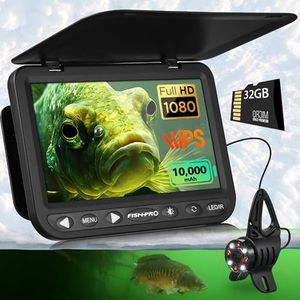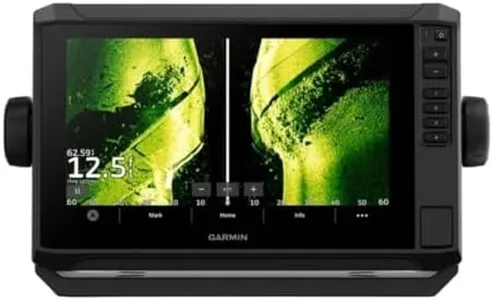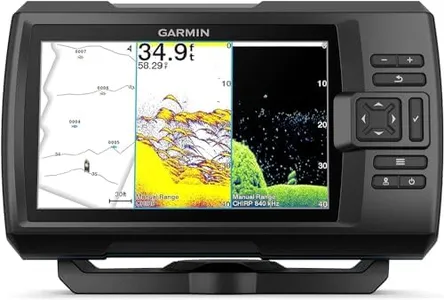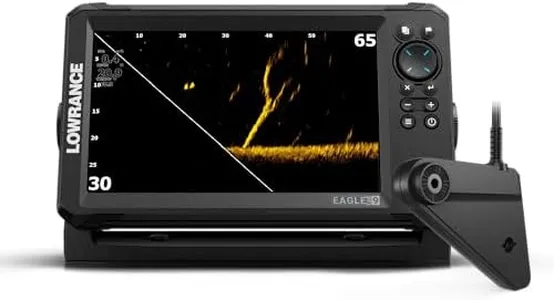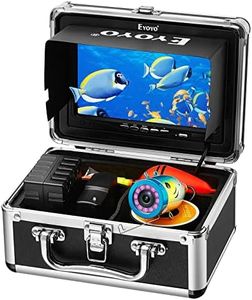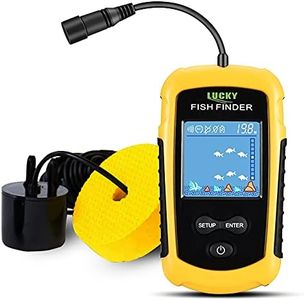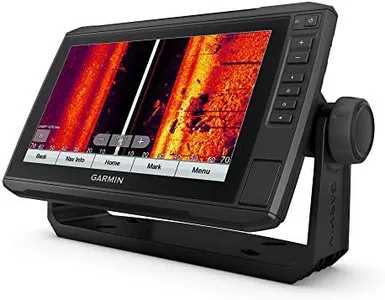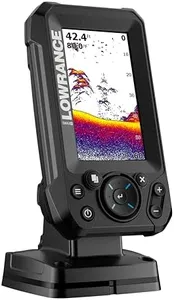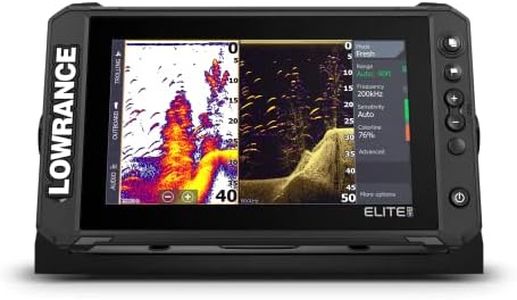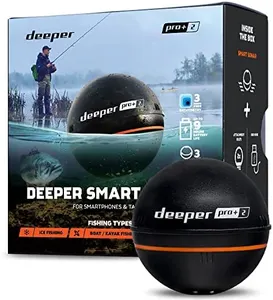10 Best Sonar Fish Finders 2025 in the United States
Our technology thoroughly searches through the online shopping world, reviewing hundreds of sites. We then process and analyze this information, updating in real-time to bring you the latest top-rated products. This way, you always get the best and most current options available.

Our Top Picks
Winner
Lowrance HDS PRO 12 Inch Fish Finder/ Chart Plotter with ActiveImaging HD 3-in-1 Transducer with Smartphone Integration
Most important from
18 reviews
The Lowrance HDS PRO 12 Inch Fish Finder stands out with its large 12-inch SolarMAX HD touchscreen, which is highly viewable even in challenging conditions, such as extreme angles or when wearing polarized lenses. This makes it very user-friendly for anglers who find themselves in various lighting conditions. The support for ultra-high-definition Active Imaging HD up to 1.2MHz ensures detailed and clear imaging, helping you locate fish more effectively.
The inclusion of a worldwide basemap and the option for various chart upgrades enhance its usability for navigation and mapping. The real-time mapping feature with C-MAP Genesis Live is particularly beneficial for creating up-to-date maps of your fishing spots on the go. Additionally, the integration with smartphone notifications and connectivity options like NMEA 2000, Wireless, and Bluetooth provides a modern touch, allowing for a more connected and automated fishing experience.
The programmable keys add to the convenience by enabling quick access to frequently used functions. However, it's essential to note that some advanced features like Sidescan FishReveal require additional modules and compatible transducers, which could mean extra costs. Portability might be a downside due to its size and the need for a 12-volt DC power source, making it less ideal for smaller boats or kayaks. Despite these considerations, the HDS PRO 12 Inch remains a robust choice for avid fishermen looking for a high-quality, feature-rich fish finder and chart plotter.
Most important from
18 reviews
Garmin ECHOMAP UHD2 94sv with GT56 Transducer, 9" Touchscreen Chartplotter, Garmin Navionics+ U.S. Coastal
Most important from
145 reviews
The Garmin ECHOMAP UHD2 94sv features a 9-inch touchscreen that is bright and easily readable even in direct sunlight, making it user-friendly for outdoor use. Its screen resolution of 1024 x 600 delivers clear and detailed images, which are crucial for fish finding and navigation. The included GT56 transducer supports traditional, ClearVü, and SideVü sonar frequencies, providing comprehensive underwater imaging to help locate fish and structure effectively.
This device also comes with built-in Garmin Navionics+ coastal charts, offering detailed map data for the U.S. coastal regions, which is particularly beneficial for coastal fishing enthusiasts. The integration of GPS enables precise navigation and route planning, enhancing fishing trips and ensuring you stay on course. Additionally, the ECHOMAP UHD2 supports wireless connectivity, allowing for the sharing of sonar data, waypoints, and routes between compatible devices. It can also connect to a Force trolling motor wirelessly, providing control over speed and battery monitoring from the chartplotter itself.
However, at 8.08 pounds, the device is relatively heavy, which may affect portability. It is designed to be mounted on a dashboard or panel, so it’s best suited for those who have a fixed location to install it on their boat. The Garmin ECHOMAP UHD2 94sv offers robust features for serious anglers, but its weight and mounting requirements may be drawbacks for those looking for a highly portable solution.
Most important from
145 reviews
Garmin LiveScope™ Plus System with GLS 10™ and LVS34 Transducer, Target Separation, Sharp Sonar Images, Vivid Color, Clear Vision, Black
The Garmin LiveScope™ Plus System with GLS 10™ and LVS34 Transducer is a powerful tool for anglers seeking precise and vivid sonar images. It boasts a large 10.1-inch LCD screen that provides clear and sharp live sonar views, making it easier to spot fish and underwater structures. The system's improved transducer technology reduces noise and sonar artifacts, which enhances the clarity of the images.
Additionally, the vivid color palettes available help in distinguishing details underwater, a useful feature for both recreational and professional fishermen. The system supports Forward, Down, and Perspective modes, offering versatility based on your fishing needs. All necessary mounts are included, making it convenient to set up right out of the box. However, it's important to note that GPS integration is not mentioned, which might require additional purchases if GPS functionality is critical for your fishing trips.
The system is battery powered, so you need to ensure you have a reliable power source during use. Weighing in at over 10 pounds, it may not be the most portable option available, which is something to consider if you need a lightweight device. This system is ideal for those who prioritize high-quality imaging and detailed underwater views, though it may not be the best choice for those seeking a highly portable and GPS-integrated solution.
Buying Guide for the Best Sonar Fish Finders
Choosing the right sonar fish finder can significantly enhance your fishing experience by helping you locate fish more efficiently. When selecting a fish finder, it's important to consider various specifications that will impact its performance and suitability for your needs. Understanding these key specs will help you make an informed decision and ensure you get the best fit for your fishing style and environment.FAQ
Most Popular Categories Right Now
